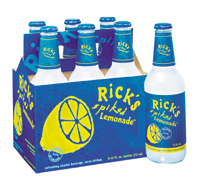| Beverages | ||
| 2000 | 1999 | |
| Hot beverages | 470 | 575 |
| RTD juices/juice drinks | 217 | 307 |
| Concentrates/mixes | 154 | 121 |
| Energy/sports drinks | 86 | 107 |
| Carbonated soft drinks | 68 | 94 |
| RTD iced tea/coffee | 102 | 80 |
| Beer/cider | 93 | 65 |
| Water | 65 | 65 |
| Flavored alcoholic drinks | 16 | 12 |
| Total | 1,271 | 1,426 |
|
Source: New Product News/GNPD & PF |
||
Big players and big risk takers were the rules of the game in the beverage market last year, replete with takeovers and breaks into new arenas.
With new beverage
launches down for the second year in a row with only 1,271 introductions,
it looks like businesses were more concerned about restructuring
than about newness. If things do settle down, however, we may see
some remarkable introductions from powerful companies, notably in
energy and fortified beverages.

Cola Clashes
For a case, you need to look no further than one of the most familiar brands in the world, Coke. Although it lost to PepsiCo in the sweepstakes for Gatorade, the company has been quite active on the acquisition front. In addition, plenty of innovations are planned for Coke's future, the most notable being a line of milk-based drinks geared toward kids. Last year, Coca-Cola introduced KMX energy drink in select regional markets.A major overhaul and revamp of Planet Java, a recent acquisition of ready-to-drink coffees, is well underway. Several drinks have been renamed and repackaged to better position them in the upcoming battle with PepsiCo's and Starbucks' market-leading Frappuccino. But will names like CaraMocha and Javadelic manage to knock down Starbucks in this faltering economic environment? Or will we retire back to our standard cup of joe?
Coke did launch a notable new product last year called Red Flash, a red soda available in the Southwest. PepsiCo, also in on the takeover action in 2000, introduced Sierra Mist, a lemon-lime soda, which was backed by significant advertising.
Teas, chais and coffee--the toasts of the town in product development in 1999--slipped a bit in 2000. Although these products' numbers held steady, the exotic flavors and herbal innovations that are usually found here were more readily popping up in the ready-to-drink convenience area.
Herbal and fortified drinks--a big newsmaker for the last couple of years--made even bigger headlines this past year with the introduction of Spire from Procter & Gamble. Although the drink looks and sounds like a European product, it is testing in a couple of cities in the States. One variety contains whey; the other is herbally fortified.
Other significant
herbally fortified drinks were launched by Triarc's Snapple and
Mistic units, now part of the Cadbury Schweppes family. Snapple
Elements is designed to compete with SoBe's line (a 2000 acquisition
for PepsiCo), and Mistic Zotics are fortified and made with exotic
fruits.

Energy Spurts
The real vitality in the beverage category occurred in the energy drink segment with Red Bull look-a-likes from a number of companies, including Virgin with its Hi-Energy drink and SoBe with its Adrenaline Rush drinks.The number of energy, herbal, and nutraceutical drink launches should rise in 2001 due to the fact that the smaller companies are being snapped up by the beverage powerhouses, as demonstrated by PepsiCo and Coca-Cola. These relatively unknown lines will have the marketing and advertising power behind them to push them into new and larger distribution channels and retail outlets.
Energy drinks also will lead in innovative packaging concepts. Energy drink containers, by their nature, take a beating during workouts and runs. Look for hand contouring and squeezable containers in 2001.
Traditional niche alcoholic purveyors are breaking into new areas in both non-alcoholic and alcoholic lines as well. Anheuser-Busch, for so many years the King of Beers, is now the producer of a non-alcoholic energy drink called 180, which is available in convenience stores. Recent reports find Allied Domecq launching a non-alcoholic iced Kahlua drink as well.
The concept of "flavored alcoholic beverages" started several years ago in Europe. They are a twist on the U.S. concept of wine coolers, and they typically contain specific types of spirits (sometimes branded), and usually are targeted to a younger market. The States saw several new entries into this market in 2000 with Seagram's Rick's Spiked Lemonade and Miller Brewing's Henry's Hard Lemonade. Other smaller companies also followed suit. Lemon growers must be experiencing sweet times, as it seems to be the juice of choice for beverage manufacturers.
Both Tropicana and Minute Maid added to their vitamin-fortified juice lines in 2000. Tropicana entered with Tropicana Plus, which is fortified with vitamins C and E, and Minute Maid Premium was manufactured with extra vitamins C and E and zinc.
The beverage market was on a roller coaster last year with new owners moving in and traditional manufacturers breaking out. Overall releases were at a near standstill. For 2001, energy and herbal drinks will continue to be the innovators. Stagnant last year, the tea category should rebound soon. PF